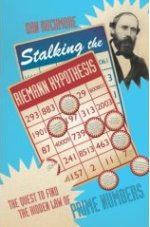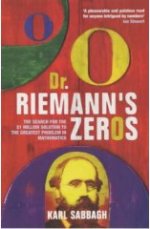Two books on the Riemann hypothesis
This review looks at two books on one of the most important, and most difficult, open problems in mathematics: the Riemann hypothesis.
 |
Stalking the Riemann
|
 |
Dr Riemann's zerosKarl Sabbagh |
Our lives are immersed in numbers. We use them to count, measure and quantify, and we need them to describe our personal data like telephone numbers, bank account details and passport numbers. We depend on them to communicate over the Internet.
Humankind has always been interested in numbers, and not only through necessity. The Pythagoreans regarded them as the atoms of the Universe and famously proclaimed that "all is number". Like many mathematicians that followed, they were interested particularly in whole numbers. There are two types of whole numbers: composites and primes. Composites, such as 4, 6, 8, 9..., are divisible by smaller numbers; we think of them as being made up of more basic number particles. These particles are the primes — they cannot be divided by other smaller numbers, except for 1. While they were of interest mostly to pure mathematicians over the centuries, primes these days also have practical applications, for example they are used in e-commerce to encrypt sensitive information.
The primes have intrigued mathematicians for far longer than the Internet has existed. Euclid, in ancient Greece, proved that there are an infinite number of them. However, his argument doesn't tell us anything about how often they appear, or in what proportion.
The primes are not distributed evenly along the number line, unlike the even numbers which march regularly to infinity in two-by-two steps. The size of the step from one prime number to the next is not regular: sometimes it is of length two (like between 29 and 31), sometimes it is huge, and as you go towards infinity the possible step size becomes larger and larger.
While trying to figure out the distribution of the primes, Carl Friedrich Gauss (commonly regarded as the greatest mathematician of all times), came up with a very accurate formula that counts the proportion of primes around a certain given number.
Leonhard Euler turned the problem on its head by considering not the primes themselves, but their reciprocals, that is, 1 divided by the prime in question. He looked at the sequence of reciprocals of the primes and used facts about the convergence of infinite series to estimate the rate of growth of the primes. In particular, if we sum the reciprocals of every natural number, the series diverges: the sum is equal to infinity. If instead we only sum the reciprocals of squares, 1+ 1/4 + 1/9 + 1/16 +..., the sum converges and is equal to π2/6. Euler concluded that since the sum of the reciprocals of the primes is infinite, but the sum of the reciprocals of the squares is finite, the prime numbers are more densely distributed than the sequence of square numbers.
In 1859, Bernhard Riemann extended this idea by allowing the sum of reciprocals raised to the power of any complex number! He defined a function, known as the zeta function, and analysing its properties, predicted a certain pattern with which the prime numbers would occur along that never-ending number line. But he couldn't prove that his prediction was true!
His assertion is now known as the Riemann hypothesis (RH) and it is the subject of the two books under review.
Stalking the Riemann hypothesis
The first, Stalking the Riemann hypothesis, is a vertiginous trip through most of the fields of modern mathematics in the quest to understand prime numbers. Considering the tricky subject at hand, the book manages quite well to explain — with a lot of hand-waving and analogies — the different approaches used to attack the RH over the years.
Author Dan Rockmore takes us into the realms of modern physics, at the boundary between physics and mathematics. He describes an interesting connection between the zeta function and quantum physics: the matrices describing the inner workings of the atomic nucleus are related to the zeta function through the energy levels encoded in the matrices.
We also learn that statistically, the RH has good chances of being true (a construction of some probabilistic primes is made for which the RH is almost always true). Many other approaches are reviewed in this book, including a few computer-based efforts.
Perhaps reflecting the inconclusive nature of the research conducted to this day, the narrative sometimes comes across as a collection of rather unconnected facts. Having said that, this book is a taster, it is a useful overview of the approaches that have been attempted so far. It covers a lot of ground, and you'll be left thinking that you have learnt a little bit about every single worthy attempt.
Disappointingly, the Riemann zeta function is never written down explicitly. In fact, the reluctance on the part of the author to include formulae complicates the task of conveying the right idea. On the other hand, the book contains plenty of entertaining anecdotes concerning the protagonists in the hunt to prove the RH, including even a Mathe-magician!
Dr Riemann's zeros
Dr. Riemann's zeros is of an altogether different flavour. The author concentrates on the art of doing mathematics, and sets himself the task of giving an insight into what makes mathematicians tick, in particular those who are directly involved in trying to find a proof of the RH.
The author focuses on one particular well-known mathematician and his struggle to convince the mathematics community that he already has a proof of the RH. This fact is almost brushed under the carpet amid the myriad of other approaches presented in Rockmore's book. We get to see the two sides of the story: many experts in the field explain why they do not believe that the claimed proof could work.
The author is not a mathematician himself, so he makes every effort to clarify the key concepts. He is not afraid of writing a few equations; in fact, he uses them to great effect. The Riemann zeta function is explained beautifully, starting from Euler's series, and there are many useful appendices at the end of the book containing most of the mathematical tools necessary to understand the content of the book (without asking us to become experts on entire functions — whatever they are!).
What this book lacks in breadth of approach, it gains in depth, and is overall a very enjoyable and inspirational read for any budding mathematician!
|
|
About the author
Karla Diaz Ordaz obtained her PhD in Mathematics at Imperial College London in 2006. After a year as a post-doc, trying to uncover the deepest secrets of mathematics on the beaches of Rio de Janeiro, she now does research on ergodic theory at the University of Warwick.
sunil kesare
hello Karla.
There is a book available on amazon.com named Tamam Shud!, which contain the exact expression for zeta(3). I hope it will helps you.
Thank you!